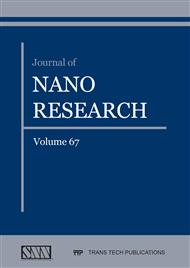[1]
L. Nkhaili, A. El Kissani, A. Elmansouri, M. Elyaagoubi, A. Outzourhit, and M. Ait Ali, Fabrication and characterization of inverted hybrid solar cells based on conducting polymers and nanostructured Zinc oxide,, 2014 Int. Conf. Electr. Sci. Technol. Maghreb, Cist. 2014, p.0–4, 2014,.
DOI: 10.1109/cistem.2014.7077047
Google Scholar
[2]
S. Sanchez, C. Lévy-Clément, and V. Ivanova, Electrochemical Deposition of ZnO Thin Films and Nanowires for Photovoltaic Applications,, J. Electrochem. Soc., vol. 159, no. 12, pp. D705–D712, 2012,.
DOI: 10.1149/2.024212jes
Google Scholar
[3]
I. Mora-Seró et al., Determination of carrier density of ZnO nanowires by electrochemical techniques,, Appl. Phys. Lett., vol. 89, no. 20, p.1–4, 2006,.
DOI: 10.1063/1.2390667
Google Scholar
[4]
S. C. Lyu, Y. Zhang, C. J. Lee, H. Ruh, and H. J. Lee, Low-temperature growth of ZnO nanowire array by a simple physical vapor-deposition method,, Chem. Mater., vol. 15, no. 17, p.3294–3299, 2003,.
DOI: 10.1021/cm020465j
Google Scholar
[5]
W. I. Park, D. H. Kim, S. W. Jung, and G. C. Yi, Metalorganic vapor-phase epitaxial growth of vertically well-aligned ZnO nanorods,, Appl. Phys. Lett., vol. 80, no. 22, p.4232–4234, 2002,.
DOI: 10.1063/1.1482800
Google Scholar
[6]
P. Yang et al., Controlled growth of ZnO nanowires and their optical properties,, Adv. Funct. Mater., vol. 12, no. 5, p.323–331, 2002,.
Google Scholar
[7]
T. Nobis, E. M. Kaidashev, A. Rahm, M. Lorenz, and M. Grundmann, Whispering gallery modes in nanosized dielectric resonators with hexagonal cross section,, Phys. Rev. Lett., vol. 93, no. 10, p.1–4, 2004,.
DOI: 10.1103/physrevlett.93.103903
Google Scholar
[8]
L. Vayssieres, Growth of arrayed nanorods and nanowires of ZnO from aqueous solutions,, Adv. Mater., vol. 15, no. 5, p.464–466, 2003,.
DOI: 10.1002/adma.200390108
Google Scholar
[9]
D. S. Souza, D. Rodríguez, and M. A. F. Medeiros, A study of the sources of slat noise using proper orthogonal decomposition,, 19th AIAA/CEAS Aeroacoustics Conf., vol. 05, no. 2, p.158, 2013,.
DOI: 10.2514/6.2013-2163
Google Scholar
[10]
L. Nkhaili et al., Effect of RF power on the structural and optical properties of RF-sputtered ZnO thin films,, EPJ Appl. Phys., vol. 66, no. 3, 2014,.
DOI: 10.1051/epjap/2014140098
Google Scholar
[11]
R. Tena-Zaera, J. Elias, C. Lévy-Clément, I. Mora-Seró, Y. Luo, and J. Bisquert, Electrodeposition and impedance spectroscopy characterization of ZnO nanowire arrays,, Phys. Status Solidi Appl. Mater. Sci., vol. 205, no. 10, p.2345–2350, 2008,.
DOI: 10.1002/pssa.200779426
Google Scholar
[12]
Y. Zhang, K. Yu, D. Jiang, Z. Zhu, H. Geng, and L. Luo, Zinc oxide nanorod and nanowire for humidity sensor,, Appl. Surf. Sci., vol. 242, no. 1–2, p.212–217, 2005,.
DOI: 10.1016/j.apsusc.2004.08.013
Google Scholar
[13]
C. Lévy-Clément, R. Tena-Zaera, M. A. Ryan, A. Katty, and G. Hodes, CdSe-sensitized p-CuSCN/nanowire n-ZnO heterojunctions,, Adv. Mater., vol. 17, no. 12, p.1512–1515, 2005,.
DOI: 10.1002/adma.200401848
Google Scholar
[14]
C. J. Chang et al., A large area bimaterial sheet of piezoelectric nanogenerators for energy harvesting: Effect of RF sputtering on ZnO nanorod,, Microelectron. Eng., vol. 88, no. 8, p.2236–2241, 2011,.
DOI: 10.1016/j.mee.2010.12.010
Google Scholar
[15]
A. Henni, A. Merrouche, L. Telli, A. Karar, F. I. Ezema, and H. Haffar, Optical, structural, and photoelectrochemical properties of nanostructured ln-doped ZnO via electrodepositing method,, J. Solid State Electrochem., vol. 20, no. 8, p.2135–2142, 2016,.
DOI: 10.1007/s10008-016-3190-y
Google Scholar
[16]
B. Scharifker, Theoretical and experimental studies of multiple nucleation,, Electrochim. Acta, vol. 28, no. 2, p.879–889, (1982).
Google Scholar
[17]
B. D. Viezbicke, S. Patel, B. E. Davis, and D. P. Birnie, Evaluation of the Tauc method for optical absorption edge determination: ZnO thin films as a model system,, Phys. Status Solidi Basic Res., vol. 252, no. 8, p.1700–1710, 2015,.
DOI: 10.1002/pssb.201552007
Google Scholar


